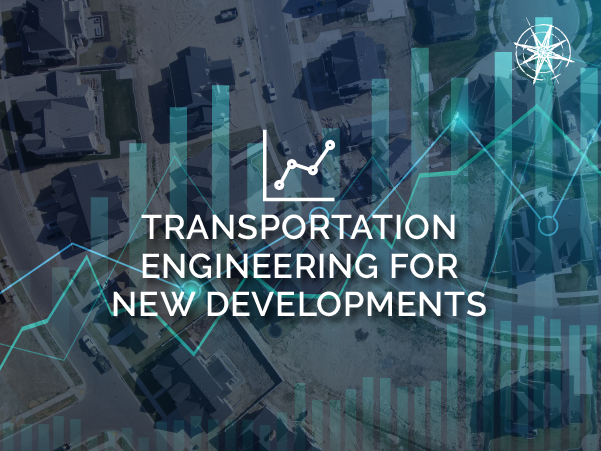
Transportation Engineering for New Developments
Ensuring Utah Communities Work for Vehicles and People
We often marvel at the many working parts and pieces of development. It literally takes a village to design and construct one! While some may say that’s a lot of bureaucracy, it’s important to remember that the health, safety, and welfare of our families and neighborhoods are directly tied to the design of our communities.
Developers and their consultants, state highway agencies, municipalities, planning agencies, elected officials, and the general public all have significant roles and interests in the site planning process. Transportation is one piece of that planning.
When a new development is built, additional roads are needed to tie into existing ones. Permits are needed to connect those two roads together or to improve the safety and efficiency of a traffic at an intersection. In order to obtain a permit, a Traffic Impact Study (TIS) is often required. A TIS helps local jurisdictions understand how the existing roadway infrastructure is operating and how the traffic generated from a proposed development is going to impact the surrounding traffic network.
Navigating the permitting process can be laborious. That’s why developers turn to FOCUS and Transportation Engineering Department Manager Jason Watson for help. Jason has completed hundreds of studies, and clients trust he will capably incorporate traffic engineering principles and standards, UDOT standards, and national practices into his work.
Here’s a glimpse into how the FOCUS Transportation Department provides solutions for a land development project:
Pre-Application Meeting
In Utah most roads are owned and maintained by the Utah Department of Transportation (UDOT) while smaller roads are owned by cities. We typically meet or have a phone call with either the local jurisdiction or UDOT to review data and define a scope and study area. That determination is based on the size and location of the proposed development and what is already surrounding it. They may consider proposed access and connection points, existing and future traffic volumes, system impacts, and mitigation measures to further define the scope of the study.
Getting to Work
This is where the team begins counting trips—total, daily, internal capture, pass-by, peak hour. They collect existing traffic counts, examine lane and intersection configurations, and identify nearby and relevant development. By looking at growth areas in the larger area, FOCUS can analyze current traffic conditions and then project how much traffic will be generated from the new development. “It’s our job to anticipate how many vehicles will be coming and going and the impact on our roadway networks,” Jason describes.
A traffic impact study often references Level of Service (LOS). It’s a ranking system for intersections and corresponds with vehicle delay in seconds and traffic flow. Similar to a report card, an A, B or C is good and means a roadway network is running smoothly. “If we see a D, E, or F grade we know there’s a need to make the traffic flow better and maintain an acceptable level of service,” explains Jason. That could mean a new traffic signal, modifying the existing traffic signal timing, a separate right turn lane, or whatever it takes to tie into an existing road and meet UDOT or municipal requirements.
The Deliverable
Whether it’s a one-page worksheet or a hundred-page report, we then break down the numbers into a digestible TIS report that is filed with an application. We may include schematic drawings highlighting roadway alignment, number of lanes, lane widths, signage, etc. If improvements are needed, we identify items like signal head locations and lane markings, as well as who is responsible for making and funding the improvements.
The application is reviewed by the approval authority. That initial kick-off meeting and follow-up coordination and communication between FOCUS and UDOT mean there shouldn’t be big surprises or comments for the development client. “From day one we’ve been working to minimize impacts and costs to the developer the best we can,” Jason points out. “The relationships and trust FOCUS has cultivated with reviewing agencies is invaluable to our clients and sets us apart in meeting project schedules.”
Once the application is approved, FOCUS turns the study recommendations into construction plans and prepares road, signal, signage, and marking plans for submittal to obtain the permits. These efforts are coordinated with our Site Civil and Survey Departments to assist with land development planning and approvals.
The work we do may seem straightforward, but each traffic impact study is tailored to the community we’re working in and the characteristics of the project. Clients and stakeholders have confidence our plans will work for both vehicles and people.

Leave a comment
You must be logged in to post a comment.